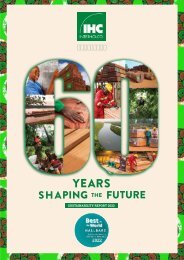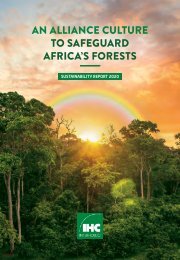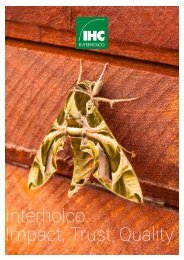Nomenclature Générale des Bois Tropicaux - 7ème édition
(english description below) Cette nomenclature est utilisée pour la mise à jour du 'Harmonized Code System' de l’Organisation Mondiale des Douanes. Dans la circulaire du 5 avril 2005, le Ministère de l’Economie, des Finances et de l’Industrie (France) reconnaît l’ATIBT comme « gardien du temple » de la nomenclature des bois tropicaux. La Commission Européenne mentionne la nomenclature de l’ATIBT comme document de référence pour la mise en œuvre du RBUE. Depuis 1954, l’ATIBT a établi et mis à jour une nomenclature des bois tropicaux faisant correspondre chaque espèce botanique avec un nom pilote reconnu internationalement. La détermination du nom pilote d’une essence est cruciale, car sa commercialisation dépend très largement de l’adoption de ce nom par le public. Le nom pilote assure la protection de l’appellation commerciale de l’essence et l’intégrité des propriétés qui lui sont attribuées, sans risque de confusion. The 1982 version of the general timber nomenclature has finally been updated as some of the 1,750 identified species, are no longer traded, while others, which were not previously included, are now on the market. The present revision has also integrated changes related to new taxonomy, in order to reflect the latest scientific developments. This Nomenclature has been used for the Harmonized Code System, updated by the World Customs Organization. The French Ministry of economy, finance and industry has given official recognition to ATIBT as the reference for the tropical timber nomenclature (NOR: PRMX0508285C of April 5th 2005). The European Commission refers to ATIBT nomenclature as a reference document for the implementation of the EUTR regulation. Since 1954, ATIBT has established and updated a nomenclature of tropical wood, linking each botanical species with an internationally recognized pilot name. A sigle wood species may have many common names; when trading across different countries, this may lead to confusion. Fixing the pilot name of a timber species is crucial, to protect the commercial denomination of the species and guarantee the veracity of the properties linked to that species, without confusion.
(english description below)
Cette nomenclature est utilisée pour la mise à jour du 'Harmonized Code System' de l’Organisation Mondiale des Douanes. Dans la circulaire du 5 avril 2005, le Ministère de l’Economie, des Finances et de l’Industrie (France) reconnaît l’ATIBT comme « gardien du temple » de la nomenclature des bois tropicaux. La Commission Européenne mentionne la nomenclature de l’ATIBT comme document de référence pour la mise en œuvre du RBUE.
Depuis 1954, l’ATIBT a établi et mis à jour une nomenclature des bois tropicaux faisant correspondre chaque espèce botanique avec un nom pilote reconnu internationalement. La détermination du nom pilote d’une essence est cruciale, car sa commercialisation dépend très largement de l’adoption de ce nom par le public. Le nom pilote assure la protection de l’appellation commerciale de l’essence et l’intégrité des propriétés qui lui sont attribuées, sans risque de confusion.
The 1982 version of the general timber nomenclature has finally been updated as some of the 1,750 identified species, are no longer traded, while others, which were not previously included, are now on the market. The present revision has also integrated changes related to new taxonomy, in order to reflect the latest scientific developments.
This Nomenclature has been used for the Harmonized Code System, updated by the World Customs Organization. The French Ministry of economy, finance and industry has given official recognition to ATIBT as the reference for the tropical timber nomenclature (NOR: PRMX0508285C of April 5th 2005). The European Commission refers to ATIBT nomenclature as a reference document for the implementation of the EUTR regulation.
Since 1954, ATIBT has established and updated a nomenclature of tropical wood, linking each botanical species with an internationally recognized pilot name. A sigle wood species may have many common names; when trading across different countries, this may lead to confusion. Fixing the pilot name of a timber species is crucial, to protect the commercial denomination of the species and guarantee the veracity of the properties linked to that species, without confusion.
Create successful ePaper yourself
Turn your PDF publications into a flip-book with our unique Google optimized e-Paper software.
Liste des noms pilotes des bois tropicaux avec renvoi aux noms scientifiques /// 85
PILOT NAME BOTANICAL NAMES COMMON NAMES
Satin wood Zanthoxylum flavum Vahl Sanders, Yellow (JM, PR) ; Espenille (GP)
Satin, Ceylon Chloroxylon swietenia A. DC. Buruta (LK) ; Satin wood (LK) ; Satin, Ceylan (IN)
Sebipira
Sempilor
Sen
Sentang
Sentul
Sepetir
Seraya, White
Sesendok
Silverballi
Simpoh
Sipo
Siris
Caesalpinia pluviosa DC.
Dacrydium beccarii Parl.
Dacrydium cupressinum Soland.
Dacrydium elatum Wall.
Dacrydium nidulum de Laub.
Dacrydium pectinatum de Laub.
Dacrydium spp.
Kalopanax septemlobus Koidz.
(Syn. Acanthopanax ricinifolius)
Azadirachta excelsa Jacobs
(Syn. Azadirachta excelsa)
Sandoricum beccarianum Baill.
Sandoricum koetjape Merr.
Sandoricum spp.
Pseudosindora palustris Symington
(Syn. Copaifera palustris)
Sindora leiocarpa Baker
Sindora siamensis Teijsm.
Sindora sumatrana Miq.
Sindora velutina Baker
Sindora spp.
Parashorea malaanonan Merr.
Parashorea tomentella Meijer
Parashorea p.p.
Shorea contorta S. Vidal
(Syn. Pentacme contorta)
Shorea p.p. subgen. Pentacme
Endospermum diadenum Airy Shaw
Endospermum medullosum L.S. Sm.
Endospermum peltatum Merr.
Aniba hypoglauca Sandw.
Aniba ovalifolia Mez
Dillenia aurea Sm.
Dillenia excelsa Gilg
Dillenia eximia Miq.
Dillenia grandifolia Wall.
Dillenia indica L.
Dillenia ovata Wall.
Dillenia spp.
Entandrophragma utile Sprague
Albizia lebbeckoides Benth.
Albizia procera Benth.
Archidendropsis xanthoxylon I.C.
Nielsen
(Syn. Albizia xanthoxylon)
Arca (PY) ; Momoqui (BO) ; Morochillo (PY) ; Pirapitá
(BO) ; Sebipira (BR) ; Sepipiruna (BR) ; Sibipiruna
(BR) ; Taperibá (AR)
Dacrydium (SB) ; Ekor (MY) ; Huon Pine (PG) ; Melor
(MY) ; Melur (ID) ; Sempilor (MY)
Sen (JP)
Limpaga (MY) ; Maranggo (PH) ; Mimba (IN) ;
Neem (IN, PK) ; Sandan (VN) ; Sentang (MY) ;
Tama (MM)
Ketjapi (ID) ; Kra Thon (TH) ; Sau Dan (VN) ; Sentul
(MY) ; Thitta (MM)
Krakas (KH) ; Krathon (TH) ; Maka-Tea (TH) ;
Meketil (MY) ; Petir (MY) ; Sepetir Pay (MY) ; Saputi
(MY) ; Sepeteh (MY) ; Sepetir Nin-Yaki (MY) ; Sindur
(ID) ; Supa (PH)
Bagtikan (PH) ; Belutu (MY) ; Lauan Malaanonan
(PH) ; White Lauan (PH) ; Pendan (ID) ; White Seraya
(MY) ; Urat Mata (ID, MY, PH)
Bakota (IN) ; Basswood (PG) ; Ekor (MY) ; Endospermum-Sasa
(SB) ; Gubas (PH) ; Hongopo (SB) ; Kauvula
(FJ) ; New Guinea Basswood (PG) ; Sendok-Sendok
(ID, MY) ; Sesendok (MY) ; Terbulan (MY)
Kawioi (GY) ; Kurero Silverballi (CR) ; Moena (PE) ;
Silverballi (GY) ; Silverballi, Yellow (CR)
Dillenia (PG) ; Simpoh (MY, SB) ; Simpur Jangkang
(ID) ; Zinbyun (MM)
Abebay (GQ) ; Asseng-Assié (CM) ; Assi (GA) ; Bokoi
(CF) ; Kalungi (AO, CD, CG) ; Liboyo (CD) ; Mufumbi
(UG) ; Sipo (CI) ; Utilé (GH, NG)
Aninapla (PH) ; Batai Batu (MY) ; Cha Kham (TH) ;
Chamchuri (TH) ; Kalo (NP) ; Kampu (TH) ; Kitoke
(ID) ; Langil (PH) ; Lim Xanh (VN) ; Oriang (MY) ;
Phruek (TH) ; Siris (IN, NP) ; Sirish (BD) ; Sirisha
(BD) ; Sirs (IN) ; Suek (TH) ; Tarisi (ID) ; Tekik (ID)














